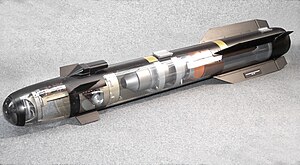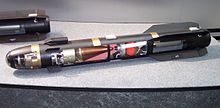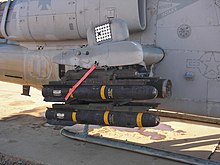AGM-114 Hellfire
| AGM-114 Hellfire | |
|---|---|
 A model of a Hellfire's components | |
| Type | Air-to-surface and surface-to-surface missile |
| Place of origin | United States |
| Service history | |
| In service | 1984–present |
| Production history | |
| Manufacturer | Lockheed Martin, Boeing (previous second source), and Northrop Grumman (seeker only for AGM-114L Longbow Hellfire) |
| Unit cost | US$117,000 (FY2017)[1] |
| Produced | 1974–present |
| Specifications | |
| Mass | 100–108 lb (45.4–49 kg)[2] |
| Length | 64 in (1.63 metres) |
| Diameter | 7 in (178 millimeters) (17.8 cm) |
| Wingspan | 13 in (0.33 m, 330 mm) |
| Warhead | High-explosive anti-tank (HEAT); 20 lb (9 kg) tandem anti-armor Metal augmented charge (MAC); 18 lb (8 kg) shaped charge Blast fragmentation |
| Engine | Solid-fuel rocket |
Operational range | 546 yd – 5 miles (500 m – 8 km) |
| Maximum speed | Mach 1.3 (995 mph; 450 m/s; 1591 km/h) |
Guidance system | Semi-active laser homing millimeter wave radar seeker |
Launch platform | Rotary- and fixed-wing platforms, unmanned combat air vehicles, tripods, ships, and ground vehicles |
The AGM-114 Hellfire is an air-to-surface missile (ASM) first developed for anti-armor use, but later models were developed for precision strikes against other target types, and have been used in a number of targeted killings of high-profile individuals. It was originally developed under the name Heliborne, Laser, Fire and Forget Missile, which led to the colloquial name "Hellfire" ultimately becoming the missile's formal name.[3] It has multi-mission, multi-target precision-strike ability, and can be launched from multiple air, sea, and ground platforms, including the Predator drone. The Hellfire missile is the primary 100-pound (45 kg) class air-to-ground precision weapon for the armed forces of the United States and many other nations.
Description
The Hellfire can be fired from rotary- and fixed-wing aircraft, waterborne vessels and land-based systems against a variety of targets.
Most variants are laser guided with one, AGM-114L "Longbow Hellfire", being radar guided.[4][5] Laser guidance can be provided either from the launcher, such as the nose-mounted opto-electronics of the AH-64 Apache attack helicopter, other airborne target designators or from ground-based observers, the latter two options allowing the launcher to break line of sight with the target and seek cover.[6]
The development of the Hellfire Missile System began in 1974 with the U.S. Army requirement for a "tank-buster", launched from helicopters to defeat armored fighting vehicles.[7][8] Production of the AGM-114A started in 1982.
The Hellfire II, developed in the early 1990s is a modular missile system with several variants. Hellfire II's semi-active laser variants—AGM-114K high-explosive anti-tank (HEAT), AGM-114KII with external blast fragmentation sleeve, AGM-114M (blast fragmentation), and AGM-114N metal augmented charge (MAC)—achieve pinpoint accuracy by homing in on a reflected laser beam aimed at the target. Predator, Reaper and AH 665 Tiger, UCAVs carry the Hellfire II, but the most common platform is the AH-64 Apache helicopter gunship, which can carry up to 16 of the missiles at once. The AGM-114L, or Longbow Hellfire, is a fire-and-forget weapon: equipped with a millimeter wave (MMW) radar seeker, it requires no further guidance after launch—even being able to lock-on to its target after launch[9]—and can hit its target without the launcher or other friendly unit being in line of sight of the target. It also works in adverse weather and battlefield obscurants, such as smoke and fog which can mask the position of a target or prevent a designating laser from forming a detectable reflection. Each Hellfire weighs 47 kilograms (104 lb), including the 9 kilograms (20 lb) warhead, and has a range of 8,000 metres (26,000 ft). The AGM-114R "Romeo" Hellfire II entered service in late 2012. It uses a semi-active laser homing guidance system and an integrated blast fragmentation sleeve warhead to engage targets that previously needed multiple Hellfire variants. It will replace AGM-114K, M, N, and P variants in U.S. service.[10]
In October 2012, the U.S. ordered 24,000 Hellfire II missiles, for both the U.S. armed forces and foreign customers.[11]
The Joint Common Missile (JCM) was to replace Hellfire II (along with the AGM-65 Maverick) by around 2011. The JCM was developed with a tri-mode seeker and a multi-purpose warhead that would combine the capabilities of the several Hellfire variants. In the budget for FY2006, the U.S. Department of Defense canceled a number of projects that they felt no longer warranted continuation based on their cost effectiveness, including the JCM.
A possible new JCM successor called the Joint Air to Ground Missile (JAGM) is under consideration. Due to budget reductions, JAGM development was separated into increments, with Increment 1 focusing on adding a millimeter wave radar to the Hellfire-R to give it a dual-mode seeker, enabling it to track moving targets in bad weather.[12][13]
Operational history
Since being fielded, Hellfire missiles have been used in combat in Operation Just Cause in Panama, Operation Desert Storm in Persian Gulf, Operation Allied Force in Yugoslavia, Operation Enduring Freedom in Afghanistan, in Operation Iraqi Freedom, where they have been fired from Apache and Super Cobra attack helicopters, Kiowa scout helicopters, and Predator and Reaper unmanned combat air vehicles (UCAVs).
The only known operational air-to-air kill with a Hellfire took place on 24 May 2001. A civilian Cessna 152 aircraft entered Israeli airspace from Lebanon, with unknown intentions and refusing to answer or comply with ATC repeated warnings to turn back. An Israeli Air Force AH-64A helicopter fired upon the Cessna, resulting in its complete disintegration.[14]
In 2008, the usage of the AGM-114N variant caused controversy in the United Kingdom when it was reported that these thermobaric munitions were added to the British Army arsenal. Thermobaric weapons have been condemned by human rights groups.[15] The UK Ministry of Defence refers to the AGM-114N as an "enhanced blast weapon".[15]
The AGM-114 has been the munition of choice for airborne targeted killings that have included high-profile figures such as Ahmed Yassin (Hamas leader) in 2004 by the Israeli Air Force,[16][17] Anwar al-Awlaki (American-born Islamic cleric and Al Qaeda in the Arabian Peninsula leader) in Yemen in 2011,[18] Abu Yahya al-Libi in Pakistan in 2012 by the United States, and Moktar Ali Zubeyr (also known as Ahmad Abdi Godane, leader of al-Shabaab) in Somalia in September 2014.[19] US officials are 99% confident that on 12 November 2015, Jihadi John, real name Mohammed Emwazi, was killed by a drone-fired Hellfire missile, while travelling in a car near Clocktower Square, in Raqqa, Syria, the place where ISIL carried out public executions.[20]
In January 2016 the Wall Street Journal reported that one training missile without a warhead was accidentally shipped to Cuba in 2014 after a training mission in Europe.[21] The dummy missile was later returned.[22] A US official said that this was an inert "dummy" version of the Lockheed system, known as a "Captive Air Training Missile". It is stripped of its warhead, fuse, guidance equipment and motor.[23][24]
Variants
This section needs additional citations for verification. (January 2016) |
- AGM-114A Basic Hellfire
- Target: Tanks, armored vehicles.
- Range: 8,000 m (8,750 yd)
- Guidance: Semi-active laser homing (SALH).
- Warhead: 8 kg (18 lb) shaped charge HEAT.
- Length: 163 cm (64 in)
- Weight: 45 kg (99 lb)
- AGM-114B/C Basic Hellfire
- M120E1 low smoke motor.
- AGM-114B has electronic SAD (Safe/Arming Device) for safe shipboard use.
- Unit cost: $25,000
- AGM-114D/E Basic Hellfire
- Proposed upgrade of AGM-114B/C with digital autopilot—not built.
- AGM-114F Interim Hellfire
- Target: Tanks, armored vehicles.
- Range: 7,000 m (7,650 yd)
- Guidance: Semi-active laser homing.
- Warhead: 9 kg (20 lb) tandem shaped charge HEAT.
- Length: 180 cm (71 in)
- Weight: 48.5 kg (107 lb)
- AGM-114G Interim Hellfire
- Proposed version of AGM-114F with SAD—not built.
- AGM-114H Interim Hellfire
- Proposed upgrade of AGM-114F with digital autopilot—not built.
- AGM-114J Hellfire II
- Proposed version of AGM-114F with lighter components, shorter airframe, and increased range—not built.
- AGM-114K Hellfire II

- Target: All armored threats
- Range: 8,000 m (8,749 yd)
- Guidance:
- Semi-active laser homing with electro-optical countermeasures hardening
- Digital autopilot improvements allow target reacquisition after lost laser lock
- New electronic SAD
- Warhead: 9 kg (20 lb) tandem shaped charge HEAT
- Length: 163 cm (64 in)
- Weight: 45.4 kg (100 lb)
- Unit cost: $65,000
- Essentially the proposed AGM-114J w/ SAD
- AGM-114L Longbow Hellfire
- Target: All armored threats
- Range: 8,000 m (8,749 yd)
- Guidance:
- Fire and forget millimeter wave radar seeker coupled with inertial guidance
- Homing capability in adverse weather and the presence of battlefield obscurants
- Warhead: 9 kg (20 lb) tandem shaped charge high explosive anti-tank (HEAT)
- Length: 176 cm (69.2 in)
- Weight: 49 kg (108 lb)
- AGM-114M Hellfire II
- Target: Bunkers, light vehicles, urban (soft) targets and caves
- Range: 8,000 m (8,749 yd)
- Guidance:
- Semi-active laser homing
- Warhead: Blast fragmentation/incendiary
- Weight: 48.2 kg (106 lb)
- Length: 163 cm (64 in)
- AGM-114N Hellfire II
- Target: Enclosures, ships, urban targets, air defense units
- Range: 8,000 m (8,749 yd)
- Guidance:
- Semi-active laser homing
- Warhead: Metal augmented charge (MAC) (Thermobaric)
- Weight: 48 kg (105 lb)
- Length: 163 cm (64 in)
- AGM-114P Hellfire II
- Version of AGM-114K optimized for use from UCAVs flying at high altitude.
- ATM-114Q Hellfire II
- Practice version of AGM-114N with inert warhead.
- AGM-114R Hellfire II (Hellfire Romeo)[25]
- Target: All Target Types
- Range: 8,000 m (8,749 yd)
- Guidance:
- Semi-active laser homing
- Warhead: Multi-function warhead
- Weight: 50 kg (110 lb)
- Speed: Mach 1.3
- Unit Cost: $99,600 (All-Up Round, 2015 USD)[26]
- AGM-114S Hellfire II
- Practice version of AGM-114K with a spotting charge instead of a warhead.
- AGM-114T Hellfire II
- AGM-114R with insensitive munition rocket motor and electromagnetic control actuators.
- M36 Captive Flight Training Missile
The M36 is an inert device used for training the handling of the Hellfire. It includes an operational laser seeker.[27]
Rocket motor

- Contractor: Alliant Techsystems
- Designation:
- M120E3 (Army)
- M120E4 (Navy)
- Main features:
- Qualified minimum smoke propellant
- Rod and tube grain design
- Neoprene bondline system
- Performance:
- Operating temperature: −43 °C to 63 °C (−45 °F to 145 °F)
- Storage temperature: −43 °C to 71 °C (−45 °F to 160 °F)
- Service life: 20+ years (estimated)
- Technical data:
- Weight: 14.2 kg (31.3 lb)
- Length: 59.3 cm (23.35 in)
- Diameter: 18 cm (7.0 in)
- Case: 7075-T73 aluminum
- Insulator: R-181 aramid fiber-filled EPDM
- Nozzle: Cellulose phenolic
- Propellant: Minimum smoke cross linked double based (XLDB)
Launch vehicles and systems
Manned helicopters


- AH-1W SuperCobra
- AH-1Z Viper
- AH-64 Apache[28]
- Agusta A129 Mangusta
- Eurocopter Tiger
- HH-60H, MH-60R, MH-60S Seahawk
- OH-58D Kiowa Warrior
- RAH-66 Comanche
- AH-6 Little Bird
- UH-60 Blackhawk
- Westland WAH-64 Apache
Fixed-wing aircraft
- Beechcraft Super King Air[29]
- AC-208 Combat Caravan[30]
- KC-130J Harvest HAWK[31]
- IOMAX Archangel[32][33]
- AC-130W[34]
Unmanned aircraft

Manned Boat
Experimental platforms
The system has been tested for use on the Humvee and the Improved TOW Vehicle (ITV). Test shots have also been fired from a C-130 Hercules. Sweden and Norway use the Hellfire for coastal defense, and has conducted tests with Hellfire launchers mounted on the Combat Boat 90 coastal assault boat.[36]
The US Navy is evaluating the missile for use on the littoral combat ship.[37] The Missile was successfully fired from a LCS in early 2017[38]
Operators

The following nations use the Hellfire:[39]
See also
References
- ^ "United States Department Of Defense Fiscal Year 2017 Budget Request Program Acquisition Cost By Weapon System" (PDF). Office of the Under Secretary of Defense (Comptroller)/Chief Financial Officer. January 2016. p. 58.
- ^ AGM-114 Hellfire Variants. GlobalSecurity.org, 25 November 2005. Retrieved 14 August 2009.
- ^ "World Missile Yearbook". Flight International, 14 March 1974, Retrieved 15 February 2017.
- ^ "Longbow Hellfire". Retrieved 27 September 2011.
- ^ "AGM-114L Longbow Missile". (shows that the L variant is called Longbow). Retrieved 27 September 2011.
- ^ "AGM-114 Hellfire Modular Missile System (HMMS)". Retrieved 27 September 2011.
- ^ John Pike. "AGM-114 Hellfire Modular Missile System (HMMS)". Retrieved 6 February 2015.
- ^ Introduction of the Hellfire – A Revolutionary Weapon to defeat the Soviet Armor Threat Archived 31 January 2009 at the Wayback Machine – Official US Army video at Real Military Flix [unreliable source?]
- ^ "AGM-114L Longbow Missile". Retrieved 27 September 2011.
- ^ Army and Lockheed Martin prepare for production of advanced laser-guided Hellfire missile - Militaryaerospace.com, 10 April 2012
- ^ Hella Lotta Hellfires - Strategypage.com, 19 October 2012
- ^ Army Reduces Scope Of Tri-Mode JAGM Aviation Week, 27 August 2012
- ^ Hellfire Replacement Step Closer With Draft JAGM RFP, Aviationweek.com, 10 June 2014
- ^ "מטוס ססנה לבנוני הופל מעל מכמורת" [Lebanese Cessna shot down over Mikhmoret] (in Hebrew). Ynet. Retrieved 6 February 2015.
- ^ a b Smith, Michael (22 June 2008). "Army 'vacuum' missile hits Taliban". The Times. London. Retrieved 22 June 2008.
- ^ Whitaker, Brian (23 March 2004). "Assassination method: surveillance drone and a Hellfire missile". The Guardian. London. Retrieved 4 December 2010.
- ^ "The Life And Death Of Shaikh Yasin". Al Jazeera. 25 March 2004. Archived from the original on 16 August 2007. Retrieved 20 October 2010.
- ^ Kasinoff, Laura; Mazzetti, Mark; Cowell, Alan (30 September 2011). "U.S.-Born Qaeda Leader Killed in Yemen". The New York Times.
- ^ Martinez, Michael (5 September 2014). "Top Somali militant killed in U.S. operation, Pentagon says". CNN. Retrieved 5 September 2014.
- ^ "How the US and UK tracked down and killed Jihadi John". The Telegraph. 13 November 2015.
- ^ Devlin Barrett, Gordon Lubold. "Missing U.S. Missile Shows Up in Cuba." The Wall Street Journal, 8 January 2016.
- ^ Klapper, Bradley (13 February 2016). "Cuba Returns Dummy Hellfire Missile Mistakenly Received". ABC News. Archived from the original on 13 February 2016. Retrieved 1 October 2017.
{{cite web}}: Unknown parameter|dead-url=ignored (|url-status=suggested) (help) - ^ "Dummy US missile disappears, turns up in Cuba". Yahoo News. 8 January 2016.
- ^ "Hellfire Missile Wrongly Sent To Cuba Was Inert, U.S. Official Says". NPR. 8 January 2016.
- ^ "Lockheed Martin Distribution Statement" (PDF). US Army. Retrieved 20 August 2015.
- ^ "AGM-114 Hellfire Missile". AeroWeb.
- ^ John Pike. "FM 1-140 Chapter 5". GlobalSecurity.org.
- ^ Apache Guardian set to deploy on May Archived 4 March 2016 at the Wayback Machine - Koreatimes.co.kr, 26 January 2016
- ^ "US sends Hellfire missiles to Iraq". Belfast Telegraph. Independent News & Media. 27 December 2013. Retrieved 27 December 2013.
- ^ "New Iraqi Airborne Strike Capability Spotted". Aviation Week & Space Technology. 14 October 2008. Retrieved 20 May 2010.
- ^ KC-130J Harvest Hawk takes on new role in Afghanistan - DVIDS
- ^ "The Archangel: Crop Duster to Tank Buster".
- ^ "Come, Gabriel, Blow Your Horn".
- ^ "The U.S. Air Force's New AC-130 Gunships Are Really Bomb Trucks". FoxTrot Alpha. 1 June 2014. Retrieved 5 September 2014.
- ^ Ahronheim, Anna (30 November 2016). "ISRAEL NAVY DEBUTS NEW SUPER DVORA PATROL CRAFT". The Jerusalem Post. Retrieved 1 October 2017.
- ^ Norwegian article about the experimental deployment of Hellfire missiles on coastal patrol boats (from the official web site of the Norwegian Armed Forces)
- ^ Muñoz, Carlo (14 January 2014). "SNA 2014: Navy Won't Rule Out Army Longbow Hellfire for LCS". news.usni.org. U.S. Naval Institute. Retrieved 14 January 2014.
- ^ United States Naval Institute (13 January 2017). "USS Detroit fires hellfire missiles in first ever test of LCS mission package". USNI News Video. Retrieved 13 January 2017.
- ^ "AGM-114 Hellfire and Longbow Hellfire", Jane's Weapon Systems, Vol. 1: Air-Launched, 19 March 2013.
- ^ "Heavy U.S. Military Aid to Lebanon Arrives ahead of Elections". Naharnet Newsdesk. 9 April 2009. Archived from the original on 30 November 2009. Retrieved 9 April 2009.
{{cite news}}: Unknown parameter|deadurl=ignored (|url-status=suggested) (help) - ^ "Proposed Foreign Military Sale to Tunisia".
External links
- AGM-114 Hellfire—Federation of American Scientists (FAS)
- HELLFIRE II Missile—Lockheed Martin
- LONGBOW FCR and LONGBOW HELLFIRE Missile—Lockheed Martin
- Designation Systems
- Global Security
- Archived copy of Navy Fact File
- Janes.com
- Hellfire Detailed Description and Images

